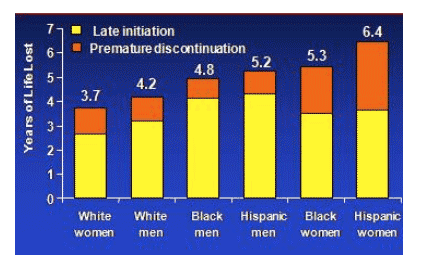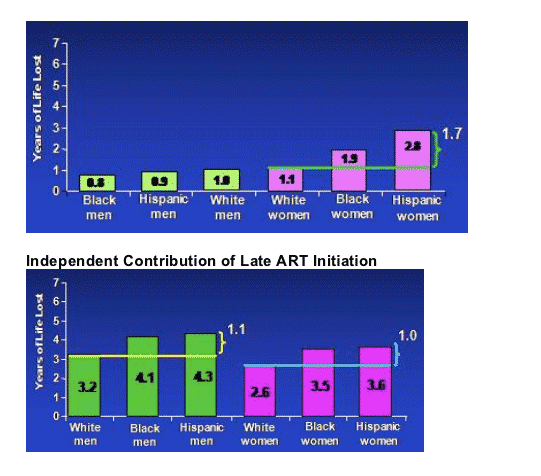 |
 |
 |
| |
Disparities in Life Expectancy Due to Suboptimal HIV Care in the US: Impact of Gender, Ethnicity and Race:
|
| |
| |
Reported by Jules Levin
CROI, Feb 2007, LA
Blacks, Hispanics, Women lose an average 1.5 years more than Whites or men due to late initiation of HAART and premature discontinuation of HAART, but white men & women also lose 3-4 year of life due to late start or discontinuation of ART
Elena Losina reported on a study funded by NIAID and reported some interesting & disturbing findings. The authors of this study used computer models for this study. Although ART has provided wonderful survival & health benefits, these benefits have been limited by poor access to optimal care "especially among women and racial minorities who often start HAART with lower CD4 counts or only after presenting for care with an OI". Goals of this study included to estimate the impact of late initiation and premature discontinuation of ART on the life expectancy of HIV-infected individuals, and to quantify the impact of gender, race and ethnic disparities on years of life lost.
"late presentation by patients for care occurred in over 33% of the overall population....but 40-50% for Blacks & Hispanics....very late presentation with CD4 count <50 occurred for 25% of the overall population, but Blacks and Hispanics were 80% more likely to present to care very late....treatment discontinuation rates ranged from 5-14%...but were highest among Black and Hispanic women".
Combined Effect of Late Initiation & Premature Discontinuation of HAART
This table shows minorities had more years of life lost compared to whites due to late initiation of HAART & premature discontinutation: 3.7 yrs lost for white women; 4.2 years for white men; 4.8 years for Black men; 5.2 years for Hispanic men; 5.3 years for Black women; and 6.4 years for Hispanic women. Hispanic women lose 2.7 years of life more than White women, and for Black women lose 1.6 years moe than White women. Losina said that sensitivity analysis showed that if ART initiation and discontinuation were similar to those in White women, life expectancies for Black & Hispanic women would increase by 1.9 and 2.7 years; and overall life expectancy for all HIV-infected women in the US would increase by 1.8 years.

Losina concluded: an estimated 16 years of life are lost per person, on average, due to HIV in the US for patients who receive guideline-concordant care I think this conclusion is questionable. I think that with proper care and treatment HIV+ individuals can live normal or close to normal lifespans). An additional 5 years are lost, per person, due to late presentation and premature discontinuation of ART. White women had the lowest rates of late initiation and premature discontinutation; they have an additional 3.7 years of lost life. Years of life lost for racial/ethnic minorities are higher than those for whites by 35%, and are greatest for women, an average 75% higher.
".....Late initiation and premature discontinuation of HIV therapy result in substantial loss of life-expectancy in HIV-infected persons in the United States. Racial/ethnic minorities lose on average 1.5 years of life more than whites. These disparities are more pronounced for black and Hispanic women, with losses of as much as 2.5 years compared to white women. Outreach efforts should focus on earlier treatment and retention in HIV care, especially for women from racial/ethnic minorities...." See abstract below following article.
Losina recommended: future outreach must focus on earlier presentation and improved retention in care for all HIV-infected persons, with particular focus on women from racial/ethnic minorities; we should expand routine, voluntary testing as a practical intervention to ensure earlier diagnosis and reduce disparities in HIV care in the USA.
Independent Contribution of Premature Discontinuation of ART

AIDS victims lose 16 years off life (the use of the word ‘victim’ bugs me, JL)
Delay in treatment forfeits more years
Ed Susman, UPI (I think)
LOS ANGELES -- On average, people who become infected with the virus that causes AIDS lose about 16 years of life, researchers said this week.
And if a person delays getting early treatment for human immunodeficiency virus infection, that individual forfeits another 5.1 years or more of life, said Elena Losina, associate professor of biostatistics at Massachusetts General Hospital/Boston University School of Public Health.
"We also calculated that in addition to lack of early treatment, the same loss of years of life occurs if there is an interruption in treatment or if a patient is non-adherent -- that is, they don't take their medicine as prescribed," Losina told United Press International at the 14th annual Retrovirus Conference in Los Angeles.
She said that disparities in care among racial and ethnic groups in the United States also tend to impact life expectancy for people living with HIV infection. For example, Hispanic women lose 6.4 years of life due to lack of access to care or acceptance of care issues. White women lose as much as 4 years of life due to delays in seeking or adhering to treatment. African-American women lose about 5.4 years of life.
She said white men who become infected with HIV lose about 4.3 years of life due to failure to optimize, implement and adhere to treatment; African-American men lose about 5.2 years, and Hispanic men lose about 5.6 years due to treatment issues.
Overall, whites lose 4.2 years; African-Americans lose 5.2 years and Hispanics lose 5.8 years, she said.
U.S.-based estimates of race/ethnicity and the time of anti-retroviral initiation. She included in her model characteristics of a patient's immune system at the time treatment was sought.
"These are models of life expectancy," she said, "and there are always likely to be some individuals who do very well and other that do not do as well."
In general, she said men and women who are 33 years old can look forward to another 44 years of life. She said that 33 years of age is the median age at which HIV infection occurs in the United States. The group of people she and her colleagues analyzed ranges in age from about 25 to about 41.
"A person who is infected with HIV in that age range will have about 28 more years of life," Losina said. "While that is 16 years less than a person who does not have the infection, it is still fairly impressive when you consider that only about a decade ago a person diagnosed with HIV was given only about two years to live."
"The best way to avoid losing so much life is not to get infected with HIV in the first place," said Wafaa El-Sadr, director of the International Center for AIDS Care and Treatment Programs and a professor of clinical medicine and epidemiology at the Mailman School of Public Health at Columbia University New York. El-Sadr moderated a news briefing at which Losina's data were presented.
"This study shows how important it is to seek diagnosis and to get into early treatment programs, as well as to remain faithful to the regimens prescribed by your doctor," el-Sadr, also the chief of the division of infectious diseases at Harlem Hospital Center, told UPI.
Disparities in Survival Attributable to Suboptimal HIV Care in the US: Influence of Gender and Race/Ethnicity
Elena Losina*1,2, Elena Losina*1,2, B Schackman3, S Sadownik1, K Gebo4, R Walensky1,5,6, R Walensky1,5,6, R Walensky1,5,6, M Weinstein7, P Lawrence4, W Aaronson1, R Moore4, and D Paltiel8
1Massachusetts Gen Hosp, Boston, US; 2Boston Univ Sch of Publ Hlth, MA, US; 3Weill Med Coll of Cornell Univ, New York, NY, US; 4Johns Hopkins Univ Sch of Med, Baltimore, MD, US; 5Harvard Med Sch, Boston, MA, US; 6Brigham and Women's Hosp, Boston, MA, US; 7Harvard Sch of Publ Hlth, Boston, MA, US; and 8Yale Univ Sch of Publ Hlth, New Haven, CT, US
Background: HIV-infected patients from underserved populations in the United States are more likely to present to care late and discontinue therapy prematurely. Our objective was to quantify gender and racial disparities in years of life lost due to suboptimal HIV care.
Methods: We used the cost-effectiveness of preventing AIDS complications model, a state-transition model of HIV disease, to estimate survival losses due to late initiation and premature discontinuation of ART. Data from the National HIV Research Network provided US-based estimates of race/ethnicity- and gender-specific distributions of CD4 cell counts at the time of ART initiation. From these data, 25% of black men presented to care with CD4 cell counts <50/mL compared to only 10% of white women. ART efficacy and subgroup-specific rates of premature discontinuation were from published studies. Rates of premature discontinuation were 14% for Hispanic women compared with 5% for white men and women. CD4 cell count and treatment discontinuation rates were varied in sensitivity analyses to assess their impact on the results.
Results:
Full adherence with current US HIV treatment guidelines leads to 9.6 years of life lost from HIV compared to survival in persons without HIV.
An additional 5.1 years of life are lost because of late ART initiation and premature ART discontinuation in the United States.
Survival losses are higher for Hispanics and blacks than for whites (5.8, 5.3, and 4.3 years, see the figure).
Compared with men, Hispanic and black women show greater survival losses, due to higher rates of premature treatment discontinuation. Mean per-person decreases in survival were 6.4 years for Hispanic women compared with 3.9 years for white women.
Conclusions: Late initiation and premature discontinuation of HIV therapy result in substantial loss of life-expectancy in HIV-infected persons in the United States. Racial/ethnic minorities lose on average 1.5 years of life more than whites. These disparities are more pronounced for black and Hispanic women, with losses of as much as 2.5 years compared to white women. Outreach efforts should focus on earlier treatment and retention in HIV care, especially for women from racial/ethnic minorities.
|
| |
|
 |
 |
|
|